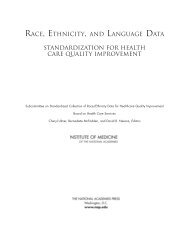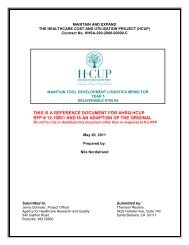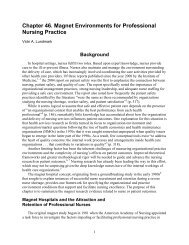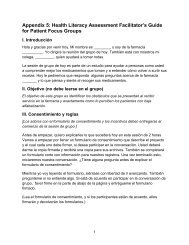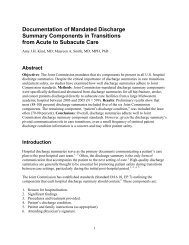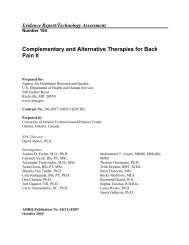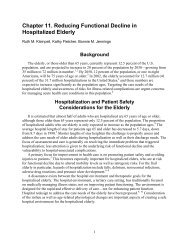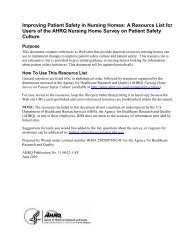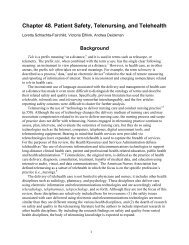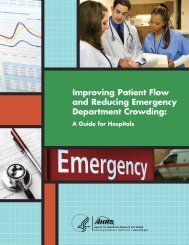Emergency Severity Index (ESI): A Triage Tool for Emergency ...
Emergency Severity Index (ESI): A Triage Tool for Emergency ...
Emergency Severity Index (ESI): A Triage Tool for Emergency ...
You also want an ePaper? Increase the reach of your titles
YUMPU automatically turns print PDFs into web optimized ePapers that Google loves.
Chapter 1. Introduction to the <strong>Emergency</strong><br />
<strong>Severity</strong> <strong>Index</strong>: A Research-Based <strong>Triage</strong> <strong>Tool</strong><br />
Standardization of <strong>Triage</strong> Acuity<br />
in the United States<br />
The purpose of triage in the emergency department<br />
(ED) is to prioritize incoming patients and to<br />
identify those who cannot wait to be seen. The<br />
triage nurse per<strong>for</strong>ms a brief, focused assessment<br />
and assigns the patient a triage acuity level, which is<br />
a proxy measure of how long an individual patient<br />
can safely wait <strong>for</strong> a medical screening examination<br />
and treatment. In 2008 there were 123.8 million<br />
visits to U.S. emergency departments (Centers <strong>for</strong><br />
Disease Control and Prevention, 2008, tables 1, 4).<br />
Of those visits, only 18% of patients were seen<br />
within 15 minutes, leaving the majority of patients<br />
waiting in the waiting room.<br />
The Institute of Medicine (IOM) published the<br />
landmark report, “The Future of <strong>Emergency</strong> Care in<br />
the United States,” and described the worsening<br />
crisis of crowding that occurs daily in most<br />
emergency departments (Institute of Medicine,<br />
2006). With more patients waiting longer in the<br />
waiting room, the accuracy of the triage acuity level<br />
is even more critical. Under-categorization (undertriage)<br />
leaves the patient at risk <strong>for</strong> deterioration<br />
while waiting. Over-categorization (over-triage) uses<br />
scarce resources, limiting availability of an open ED<br />
bed <strong>for</strong> another patient who may require immediate<br />
care. And rapid, accurate triage of the patient is<br />
important <strong>for</strong> successful ED operations. <strong>Triage</strong> acuity<br />
ratings are useful data that can be used to describe<br />
and benchmark the overall acuity of an individual<br />
EDs’ case mix. This is possible only when the ED is<br />
using a reliable and valid triage system, and when<br />
every patient, regardless of mode of arrival or<br />
location of triage (i.e. at the bedside) is assigned a<br />
triage level (Welch & Davidson, 2010). By having<br />
this in<strong>for</strong>mation, difficult and important questions<br />
such as, “Which EDs see the sickest patients?” and<br />
“How does patient acuity affect ED overcrowding?”<br />
can then be answered. There is also growing interest<br />
in the establishment of standards <strong>for</strong> triage acuity<br />
and other ED data elements in the United States to<br />
support clinical care, ED surveillance,<br />
benchmarking, and research activities (Barthell,<br />
Coonan, Finnell, Pollock, & Cochrane, 2004; Gilboy,<br />
Travers, & Wuerz, 1999; Haas et al., 2008; Handler et<br />
al., 2004; National Center <strong>for</strong> Injury Prevention and<br />
Control, 1997).<br />
1<br />
Historically, EDs in the United States did not use<br />
standardized triage acuity rating systems. Since<br />
2000, there has been a trend toward standardization<br />
of triage acuity scales that have five levels (e.g., 1resuscitation,<br />
2- emergent, 3- urgent, 4- less urgent,<br />
5- nonurgent). The <strong>Emergency</strong> Nurses Association<br />
(ENA) and the American College of <strong>Emergency</strong><br />
Physicians (ACEP) <strong>for</strong>med a Joint <strong>Triage</strong> Five Level<br />
Task Force in 2002 to review the literature and make<br />
a recommendation <strong>for</strong> EDs throughout the United<br />
States regarding which triage system should be used.<br />
Prior to this task <strong>for</strong>ce work, there were a variety of<br />
triage acuity systems in use in the United States,<br />
dominated by three-level scales (e.g., 1-emergent, 2urgent,<br />
3-nonurgent). The following position<br />
statement was approved in 2003 by the Board of<br />
Directors of both organizations: “ACEP and ENA<br />
believe that quality of patient care would benefit<br />
from implementing a standardized emergency<br />
department (ED) triage scale and acuity<br />
categorization process. Based on expert consensus of<br />
currently available evidence, ACEP and ENA support<br />
the adoption of a reliable, valid five-level triage<br />
scale” (American College of <strong>Emergency</strong> Physicians,<br />
2010; <strong>Emergency</strong> Nurses Association, 2003). The<br />
task <strong>for</strong>ce published a second paper in 2005 and<br />
specifically recommended EDs use either the<br />
<strong>Emergency</strong> <strong>Severity</strong> <strong>Index</strong> (<strong>ESI</strong>) or Canadian <strong>Triage</strong><br />
and Acuity Scale (CTAS) (Fernandes et al., 2005).<br />
Both <strong>ESI</strong> and CTAS have established reliability and<br />
validity. In 2010 the ACEP revised the original<br />
statement: “The American College of <strong>Emergency</strong><br />
Physicians (ACEP) and the <strong>Emergency</strong> Nurses<br />
Association (ENA) believe that the quality of patient<br />
care benefits from implementing a standardized<br />
emergency department (ED) triage scale and acuity<br />
categorization process. Based on expert consensus of<br />
currently available evidence, ACEP and ENA support<br />
the adoption of a reliable, valid five-level triage scale<br />
such as the <strong>Emergency</strong> <strong>Severity</strong> <strong>Index</strong> (<strong>ESI</strong>)” (ACEP,<br />
2010). Following the adoption of this position<br />
statement, the number of EDs using three-level<br />
triage systems has decreased, and the number of EDs<br />
using the five-level <strong>ESI</strong> triage system has increased<br />
significantly (McHugh & Tanabe, 2011).<br />
Some hospitals continue to use other triage systems.<br />
In 2009, the American Hospital Association reported<br />
the following survey data in which hospitals<br />
reported which triage system they used:. <strong>ESI</strong> (57%),<br />
3-level (25%), 4-level (10%), 5-level systems other



